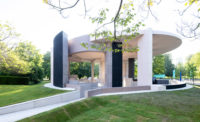After receiving masters of architecture degrees from Princeton University in 2010, Julian Rose and Garrett Ricciardi formed a partnership with a name—Formlessfinder—that reflects their shared theoretical bent. They proceeded to explore formlessness in architecture and related disciplines with a symposium at the Storefront for Art and Architecture in 2011 and a book for Lars Müller, the Swiss publisher, to be released next month. Their only built project, expressing their desire to leave materials, whenever possible, in their natural state, was a small addition to a house near Princeton.
But a “cold call” from the organizers of Design Miami may have changed the course of their careers. Each year, the organizers choose a firm to design an entry pavilion for the Design Miami tent, a supermarket-sized structure erected in the parking lot of the Miami Beach Convention Center. Last year, the commission went to Snarkitecture (Alex Mustonen and Daniel Arsham), who worked with inflatables; in 2011, the pavilion was a timber construction by architect David Adjaye.
This year, Design Miami founder Craig Robins and director Marianne Goebl selected Formlessfinder, whose partners work out of apartments in Brooklyn. The commission is giving them a chance to realize their ideas in three dimensions (with the help of consultants like structural engineer Nat Oppenheimer of Robert Silman Associates) and will bring them wide attention when Design Miami opens on December 3.
Formlessfinder’s design consists of an aluminum-truss roof that appears to sit on a large pile of sand (70 feet wide at its base). The sand will be real (500 tons of it, they say) and it will stabilize the structure that supports the roof, which would otherwise require subterranean bracing. “It works as a ballast, in lieu of a more traditional foundation,” say Rose, of the sand. Alcoa donated the material for the roof, which is being milled at cost by the Neal Feay Company of Santa Barbara.
Formlessfinder’s design consists of an aluminum-truss roof that appears to sit on a large pile of sand (70 feet wide at its base). The sand will be real (500 tons of it, they say) and it will stabilize the structure that supports the roof, which would otherwise require subterranean bracing. “It works as a ballast, in lieu of a more traditional foundation,” say Rose, of the sand. Alcoa donated the material for the roof, which is being milled at cost by the Neal Feay Company of Santa Barbara.













Post a comment to this article
Report Abusive Comment